#dowager queen of england
Text

On this day in History, 10 June 1432, Jeanne d'Évreux, daughter of Navarre, died at Havering-atte-Bower. She was formerly Duchess of Brittany by her first marriage, and Queen of Enfland by her second marriage, which was a love union. Despite being imprisoned for some years by her stepson, Henry V, Joan (as she was better known by her English subjects) still received visits from her stepchildren such as Humphrey of Gloucester and John of Bedford, but more often her Beaufort in-laws like Cardinal Beaufort. She was buried next to Henry.
#house of lancaster#house of evreux#jeanne d'evreux#joan of navarre#henry iv of england#queen joan#dowager queen of england#dowager duchess of brittany#plantagenet dynasty
12 notes
·
View notes
Text




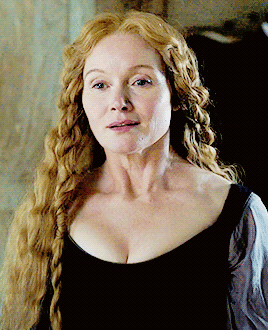

𝑰𝒏𝒕𝒆𝒓𝒏𝒂𝒕𝒊𝒐𝒏𝒂𝒍 𝑹𝒐𝒚𝒂𝒍/𝑰𝒎𝒑𝒆𝒓𝒊𝒂𝒍 𝑯𝒊𝒔𝒕𝒐𝒓𝒚 𝑨𝒑𝒑𝒓𝒆𝒄𝒊𝒂𝒕𝒊𝒐𝒏 𝑴𝒐𝒏𝒕𝒉:
𝑾𝒆𝒆𝒌 1: 𝑸𝒖𝒆𝒆𝒏/𝑬𝒎𝒑𝒓𝒆𝒔𝒔 𝑫𝒐𝒘𝒂𝒈𝒆𝒓𝒔
𝑫𝒂𝒚 1: 𝑬𝒍𝒊𝒛𝒂𝒃𝒆𝒕𝒉 𝑾𝒐𝒐𝒅𝒗𝒊𝒍𝒍𝒆, 𝑫𝒐𝒘𝒂𝒈𝒆𝒓 𝑸𝒖𝒆𝒆𝒏 𝒐𝒇 𝑬𝒏𝒈𝒍𝒂𝒏𝒅
#elizabeth woodville#dowager queen of england#the white princess#international royal/imperial history appreciation month:week 1
16 notes
·
View notes
Text

Curiously enough, I’ve only recently watched “Becoming Elizabeth” as I’ve concomitantly read Edward VI’s biography.
It is hardly a surprise to observe there were great differences between the show and the book, specially concerning Katheryn Parr and Thomas Seymour’s own relationship.
Admittedly, though I know little of this matter myself, came across the excerpt below which gave me a lot to think about. For those who are little familiar with the first Dowager Queen of England in an almost a century (the last being Queen Elizabeth Wideville), the following content might actually come a surprise—or not.
What matters here is to promote not only a healthy discussion about their union, but showing that whereas Katheryn did love the man, she was not his first option to marry and she was not a “fool” completely blinded by her affection for him: she hesitated at first, unwilling to remarry in at least two years before becoming Lady Seymour out of respect for the king of England. However, Lord Thomas was a persuasive man, writing as far as a poem to claim the dowager queen’s heart—and he eventually succeeded it, as we are seeing next.
“Katherine moved into her dower house at Chelsea - away from the eyes at court, it was the ideal setting for Seymour to pay secret visits by night. Letters were sent and received, their contents, upon Katherine's urging, were quickly burnt: 'Your letter being finished ... I remembered your commandment to me’, Seymour wrote, ‘wherewith I threw it into the fire, be minding to keep your requests and desires’, yet the survival of both their letters suggest that neither was quite so willing to part with these tokens of love and affection.
Katherine confided her feelings to her friend Lady Paget, who urged marriage. But Katherine was hesitant. She wished 'it had been her fate to have him for a husband' but she was mindful of her position as queen. She had even kept the affair secret from her sister Anne who, when Katherine finally revealed the news, 'did not a little rejoice'.
As a growing number of friends discovered the secret of the affair, it became increasingly difficult to keep it hidden and rumours soon abounded. Meeting Seymour in St James's Park, Princess Elizabeth's servant Katherine Ashley challenged him over his marriage plans. Seymour boasted 'he would prove to have the queen', to which Ashley retorted that she thought this 'was past proof as I had heard he was already married to her'.
Ashley was right, for sometime between mid May and the beginning of June the couple had wed in secret, with one commentator believing the marriage had taken place as early as thirty-four days after Henry's death.
If this was true, then Katherine was playing a dangerous game - if she had become pregnant, there would have been no certainty that the child was Seymour's or Henry's. Katherine remained unwilling to commit herself, having doubts to the last.
She claimed she was his 'loving wife in her heart' but was determined 'never to marry, and break it when I have done, if I live two years'. Nevertheless, Seymour got his way. News of their marriage could not stay secret for long.
'I wish the world was as well pleased with our meaning as lam well assured [of ] the goodness of God's’, Katherine had lamented, 'but the world is so wicked that it cannot be contented with good things’. Instead she suggested that they find support for their union amongst the most powerful members of the council and court.
Seymour tested Princess Mary's reaction. It was not good. Mary considered it 'strange news', writing that if Katherine was keen, there was little she could do. In any case, 'being a maid' she was 'nothing cunning' about 'wooing matters'.
Instead, Mary appealed to her dead father's memory: if Katherine was not willing, certainly she would not 'persuade her to forget the loss of him, who is as yet very ripe in mine own remembrance’. Privately Mary was horrified at the prospect, and blamed Katherine for the affair. She possibly even appealed to Elizabeth to discourage the queen, but her half-sister, not wishing to stir up trouble, told her that they lacked any influence at court and should suffer with patience what was impossible to prevent.
Seymour would have to look elsewhere for support and he knew precisely whom to turn to. His confidence rested in the fact that he had managed to remain in regular contact with Edward through John Fowler, a Gentleman of the Privy Chamber, whom Seymour gave a bribe of £10 (£3,000) shortly after the coronation and before long was in his regular pay. Despite being almost continually in the presence of other gentlemen of the chamber, Fowler was soon able to converse with Edward and soon struck up a close friendship with the king, speaking to him alone.
It was not long before Seymour was calling in the favours. At the end of February he had met with Fowler over a drink and asked whether Edward had mentioned him - and in particular whether the king had ever wondered why he had remained unmarried. Would Edward be happy for him to marry? And who should he take as his bride?
Without asking too many questions, Fowler approached Edward a few days later, somewhat unsubtly repeating Seymour's queries. Edward's first reply was to suggest Anne of Cleves, but then, giving the matter more serious attention, answered that he thought Mary to be the best choice, if only 'to change her opinions'.
When Seymour heard, he laughed. 'I pray you, Mr Fowler, if you may soon, ask his Grace if he could be contented I should marry the Queen.’ He also wanted to know if Edward would write a letter on his behalf in support of the marriage.
It was at this time that Seymour, without Fowler's knowledge, began to visit Edward in private. It was not long before he had persuaded him to write a letter to Katherine, dated 25 June. Despite Edward writing to Katherine at the end of May urging her to 'continue to love my father', now the king seemingly endorsed her relationship with Seymour, since the letter ingeniously made their marriage appear as Edward's personal request to Katherine.
Moreover, it gave specific assurance that Edward would safeguard Katherine against any reaction from Somerset, who the couple knew would be furious at their secret union: 'Wherefore ye shall not need to fear any grief to come, or to suspect lack of aid in need; seeing that he, being mine uncle, is so good in nature that he will not be troublesome ... if any grief shall befall, I shall be a sufficient succour.'
The entire letter was no doubt composed by Seymour, who probably dictated it to the king.(…) When news of his brother's marriage leaked out, Somerset was furious. Edward's blessing made Somerset all the more enraged, and the king was not immune from the brunt of his anger, noting in his journal that 'the Lord Protector was much offended’.
But it was his wife Anne, the Duchess of Somerset, who took the greatest offence to the union. Described as 'a woman for many imperfections intolerable, and for pride monstrous, subtle and violent' who held Somerset under her sway 'by persuasions cunningly intermixed with tears', she detested Katherine.”
SKIDMORE, C. “Edward VI: The Lost King of England”.
#tudor dynasty#Edward VI#Katheryn Parr#Queen Katheryn Parr#Queen Catherine Parr#Queen Katheryn#Queen Catherine#Queen Katherine#Dowager Queen of England#House of Tudor#Thomas Seymour#Lord Thomas Seymour#Baron Sudeley#Lord Admiral#House of Seymour#Edward Seymour#Anne Stanhope#Duke of Somerset#Duchess of Somerset#Will write about Anne and Katheryn’s rivalry in a future post.#Princess Mary Tudor#Princess Mary#Lady Mary Tudor#Queen Mary I of England#Princess Elizabeth#Lady Elizabeth Tudor#Queen Elizabeth I of England
9 notes
·
View notes
Text
Letter written by Lady Elizabeth Tudor to Dowager Queen of England, Katheryn Parr.
“Although I coulde not be plentiful in giving thankes for the manifold kindenis received at your hithnis hande at my departure, yet I am some thinge to be borne with al, for truly I was replete with sorowe to departe frome your highnnis, especially leaving you undoubtful of helthe, and albeit I answered litel I wayed [weighed] it more dipper [deeper] when you sayd you wolde warne me of al evelles that you shulde hire of me, for if your grace had not a good opinion of me you wolde not have offered friendship to me that way, that al men iuge [judge] the contrarye, but what may I more say than thanke God for providinge suche frendes to me, desiringe God to enriche me with ther [their] longe life, and me grace to be in hart no les thankeful to receyve it, than I nowe am glad in writinge to shewe it. And although I have plentye of matter, hire I wil staye [stop] for I knowe you ar not quiet to rede. Frome Cheston this present saterday.”
Link: national archives.gov.uk for

#tudor dynasty#Elizabeth I of England#elizabeth Tudor#queen elizabeth#queen Katherine#queen Katherine parr#dowager queen of England#Katherine parr#katheryn parr#Tudor England
30 notes
·
View notes
Text


~The salvation of the sinner: a queen and her knight [a world where there’s no Thomas Seymour]~ [part I]
28 January 1547. Palace of Whitehall.
Once again, Katheryn Parr was left a widow. Three husbands went to the grave, leaving a vast inheritance for her and great responsibilities to lead. For the first time since 1483, England had a Dowager Queen of England. But beneath the title and the official grieving, there lied a woman who ached for something she did not know.
Or perhaps she did. Though dutiful as she was, she remained a woman with needs and sentiments. But it’s been so long she knew duty that by now duty was all she knew. She had little time to think about it. She may not be queen anymore, she could breathe out of relief now that the king she feared lives no more, nonetheless... there were duties (as often were) expecting to be performed.
That year promised to be tough for Katheryn. The former queen of England was treated with respect and all honours to her position. Yet, something seemed amiss... She felt unhappy, and could hardly mask her sentiments, also used for political reasons. To many, she was not merely a grieving queen, but a grieving wife.
She leaned on her duties as a widow and as queen, giving space to her stepson fulfill his role as king in spite of his age. Katheryn was aware that some close to him--and she suspected this would be in the person of the Duchess of Somerset--saw her with suspicious: as a dowager queen, young and beautiful, could she remarry?
Staying at the court was too much for her, though. Katheryn wanted nothing to do with politics. So that way she announced to king Edward her wishes of departing to her inheritance at the north, right at the castle of Sudeley. Her heart seemed to break when she saw the disappointment in Edward’s eyes.
He wants me to stay. I wish I could, but I cannot.
When she stepped towards him, she knelt so she could match his height even though Edward was growing taller for his age.
“Your Majesty, I’ll never be far from you. I assure you that when you need me, I’ll be here for you to serve and obey.” Katheryn smiled. She was genuinely fond of the boy. “Write me as much as you wish, but be mindful of your duties. Always. To God, to England and to your conscience.”
“Of course, my lady. May He bless you.” There were unspoken words, choked by formalities that, nonetheless, reached those piercing blue eyes. Katheryn embraced him fondly.
But before she was ready to depart with her retinue, the king told her he’d not let her to move north without good men to protect her. That was how she was introduced to this knight, a loyalist named Anakin Skywalker.
***
Anakin had been sent by the Jedi Council in order to prevent the Planet Earth to suffer further attacks by the Separatists. In that manner, he was instruced to spend one or two years in each part of that region in order to make sure they were seized and sent to jail. But after a while, Obi-Wan contacted him to instruct his Padawan another mission he was to take: to protect the Dowager Queen of England and make sure she’d not fall victim to the enemies’s hands.
“I thought most of them had been destroyed”, said Anakin, rather out of surprise.
“Unfortunately, some of them are still yet to be found”, lamented Obi-Wan. “When I get more information, I’ll send those to you. But in the meantime, do as you are told. Be careful, Anakin. This planet, as far as I know, is a very odd one in matters of costumes and thoughts.”
The younger Jedi snorted. “As if spending almost three years and a half here had not showed me that. But I’ll be careful, Master, do not worry about that.”
After that, much against his will, he went to this England kingdom where, as everything was arranged, he was expected to meet it’s new king. To his surprise, Anakin was met by a youngling.
Could younglings rule with the authority of a king? My, Obi-Wan was right in saying this is a very odd planet.
Even though Anakin could tell there was a council to respond for the king’s actions and rule in his behald until he reached majority, it was difficult for him to take the words of nine year old seriously. Yet, he could not dismiss the task he was assigned for. So he waited.
“My lord, I am glad your journeyed to us safely. I pray you came with no trouble whatsoever?”
Anakin had little patience to deal with politics and all that formalities due to the position they occupy, but when looking at the youngling standing right in front of him, the Jedi came to know this was a child who would never know the delights of infancy, whose innocence was being stripped away by the heavy burden he was expected to carry until the day he died. When coming to this perspective, Anakin pitied him.
So his featured softened as he addressed the boy king:
“I did, yes, Your Majesty. I appreciate your concernings. I pray to find you well this day too, my lord. One can only think of all the duties that have been taking your day.”
Edward seemed to sympathize with him and Anakin smiled as he perceived it through the Force.
“Indeed, sir. A king is expected to attend meetings and bring many solutions to a realm’s issues.” A reply that got Anakin’s eyebrows lifted. “The reason why we fetched you to us is that we require your services to protect our mother, the dowager queen of England. She has informed us her desire to depart to the north but we fear for her security.”
“I will do as Your Majesty commands”, vowed Anakin, bowing his head.
“We appreciate it”, said the king, looking relieved.
Anakin wondered if there was another reason why he’d feel this way, but one could only especulate.
“Do you have a date, Majesty?”
It was when he heard the voice of the king’s regent for the first time.
“As soon as possible”, said the duke of Somerset. “We sincerely wished she’d stay in order to follow the proceedings to His Majesty’s governing, becoming the point where the last regime is supplanted by a new one.”
Anakin glanced at the regent with suspicious eyes, but dared not to speak his mind. I’m here to fulfill my duty, that is all.
“I’m staying here until I am further needed then”, informed the Jedi.
The duke of Somerset stared at him cooly, almost as if he was foreseeing the future.
“I’ll make sure to inform you the date, my lord.”
***
So there they were. The former queen entered the carriage with lady Elizabeth and Anakin as her ladies would come in a different vehicle. Katheryn had found Anakin pleasant to her eyes, not expecting a knight to be possessed with such...handsomely features.
Nonetheless, she masked her perceptions well, even though the Jedi Knight could tell something was going through her mind. But out of respect he decided not to investigate.
“You are a quiet man”, said the queen after a while. They were sitting in front of each other and as gallops began the pace, the journey out of the court she detested relieved her spirits. “My daughter and I were wondering what kind of knight you may be.”
Anakin turned his storming eyes to the red-headed young princess that took the queen’s side. Her dark eyes, a contrast to Katheryn’s light brown eyes, were staring curiously at him. The Jedi could tell he was being avaliated as if he was worth of the royal presence’s trust. He almost found that amusing.
Looking back at the mistress he was expected to protect and serve, he could not help but feeling captivated by her ginger locks and coy smile. But I know my place.
“I am a man of actions, my lady. I fear I am not one very much of words”, said he simply.
“On that case, I should be the judge of that”, remarked Katheryn with a sly smirk. “But between us, sir, why would a widow like myself be in danger in this country, enough to have a knight as yourself as a protector?”
“I am but a knight, Your Majesty, not a politician”, said Anakin, though a small smirk could be seen twitching upon his lips.
“Even so, a knight has opinions. We all have”, she insisted. “What could I possibly offer to earn a great deal of protection? Is it because of the title fairly bestowed to me?”
“You ask me difficult questions, Majesty. A knight who serves does not dare to questions the duties he’s been assigned to.”
It was when lady Elizabeth intruded in the conversation:
“You speak like an Arthurian knight. Surely a man like yourself must be familiar with the doings of Lancelot or, better yet, William the Marshall.”
Anakin did no respond her right away. All these years spent in that Planet, especially with the nobility, told him how proud of their ancestors those people could be. Sometimes he missed the Galactic Republic where these things were far less perceptible. A voice in the back of his mind wondered whether duchess Satine would ever praise those who came before her in such a manner.
But, however homesick he may be, he knew it was not his place to judge these people. He actually remembered Ahsoka, his Padawan, and how she liked to point his knightly virtues whenever Obi-Wan criticized him. A memory ever so cherished almost brought a smile to his lips.
“Indeed. Although I do not think I mirror myself in Lancelot this much, Your Highness.”
“Oh. Why not?”, inquired lady Elizabeth, rather baffled for meeting someone who does not look up to Lancelot.
“Knights who betray their masters to love their queens are not worthy of praising. It’s dishonest if I may speak freely”.
“That is a concept few discuss upon”, said Katheryn, observing the conversation. “But a king ever so cold should leave his queen unloved?”
Anakin had no answer to matters of love. In fact, as Obi-Wan liked to point out to him, he was far too judgemental where he lacked experience. Hence the silence.
“You should not be afraid to speak your mind, my lord. We are friends here”, she assured him. “Besides, we are merely discussing a novel we all enjoy ourselves reading, are we not?”
But was it really? Not even Katheryn had the response, perhaps fearful of what it might be. As the three of them began to grow quieter and lady Elizabeth fall asleep, she was reminded of the days she was queen. Afraid of what her fate would be, how often wasn’t she found praying for safety? How often wasn’t she... afraid, fearful for her life?
It feels strange to be released of my marital vows. To be alone once again. A widow one more time. I’m free. But freedom has a different taste to my tongue.
As if he was capturing her thoughts, Anakin broke the silence, intrigued by her presence:
“What was it like to be his queen?”, the Jedi knight inquired, surprising Katheryn by his sudden interest.
“It was...”, she hesitated. Could she trust him with the truth? Though in his eyes, she knew she could, Katheryn would rather protect herself. “...a privilege. I was content. He was a good husband.”
Neither believed in the lies that rolled out so naturally of her tongue.
“I wish I could have given him children”, said she, more to herself. “Then I would have fulfilled the role I was expected to perform. Being a queen, my lord, is more than wearing fine robes and exhibing jewelry. It is more than being a dutiful wife.”
She smiled, but it was devoid of joy. Anakin felt her pain.
“But God willed me to be barren, I suppose.”
“And yet you survived him”, the words he spoke came naturally. He should regret it, but he did not.
Katheryn smiled at his blunt words, but this time her smile was more sincere.
“As God wanted me to. Who are we when He calls us home? Who are we before his will?”
“Forgive me for being rather cheeky, Your Grace, but do you not have any doubts? Have you never...questioned?”, Anakin found himself unable to part the gaze that so suddenly held them both captive of one another.
He asks me if I have questioned my faith. Katheryn stared at him in silence. I could reprehend him, but... when I was chosen to be queen, did I not question Him? Did I not falter before the great test He put me to proof?
And Anakin’s words (”and yet you survived him...”) continuously hammered against her mind.
“When you have faith, master Skywalker, adversities come to test you. But even when we are surrounded by storms of every kind, we ought to be thankful and praise the Lord for the opportunity of showing Him why He chose us.”
The Jedi said nothing else as he reclined back against the wall and with a sigh, looked away. Through the window, he observed the rise of twilight, watching the sunset and the rise of stars. Soon the moon would come. The journey seemed to weight on him.
“Did you ever come to good terms with your conscience upon the doubts that haunt you?”, inquired Katheryn.
As Anakin looked back at the queen, he was baffled by how easily she read him. And yet I don’t feel the force in her.
She smiled.
“I have come to other men like you before. It is natural that when we come across some trauma, we respond it with questions. My... my late husband was not different. Do not put so much pressure on you. Soon, He will give you the answer you are looking for, whatever that may be.”
The Jedi did not say nothing for a long time. Yet, suddenly he heard himself saying:
“Do we all deserve salvations, Your Majesty?’
To which Katheryn, giving him a knowing glance, responded:
“We do, Master Skywalker. As sinners we all may be, God does not turn away from those He chooses. Something tells me you are soon to find a salvation yourself.”
Anakin chuckles softly, but a sort of sadness glinted in his eyes.
“I pray you are right, Your Majesty.”
Katheryn offered her hand to take and as he reluctantly did so, she closed her eyes and prayed. The simplicity in the words that the Jedi heard soothed the darkness that not so long ago threatened to choke his light side. It all seemed that, by her side, he found the balance he needed all along...
(to be continue)
#Anakin Skywalker#Darth Vader#Star Wars imagine#Star Wars crossover#Anakin Skywalker x reader#Jedi#the Force#Katheryn Parr#Queen Katheryn#Catherine Parr#Katherine Parr#Katheryn x Anakin#crossover#Tudor crossover#Tudor England#Dowager Queen of England#Henry VIII#Lady Elizabeth Tudor
20 notes
·
View notes
Text
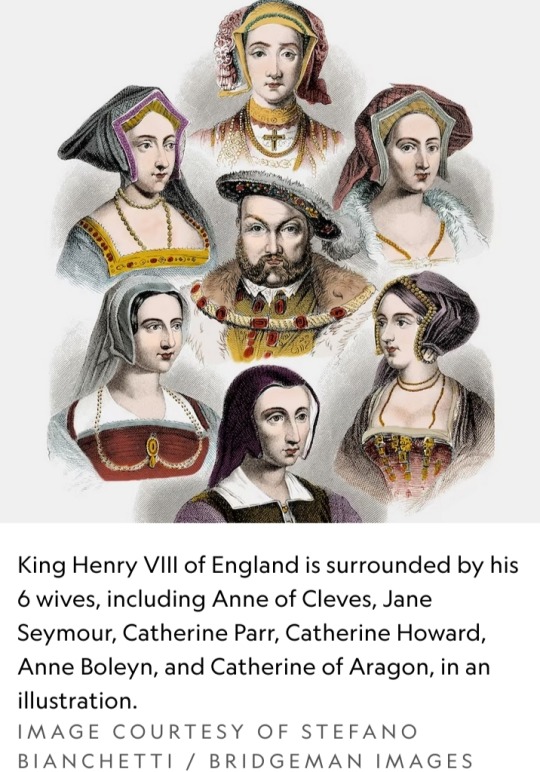

Authors Toby Marlow and Lucy Moss found inspiration for their hit musical in the lives and loves of King Henry VIII, but SIX tells the story from the women’s point of view.
Each queen gets her moment in the spotlight to explain her fate of being “Divorced. Beheaded. Died. Divorced. Beheaded. Survived.”
Divorced: Catherine of Aragon
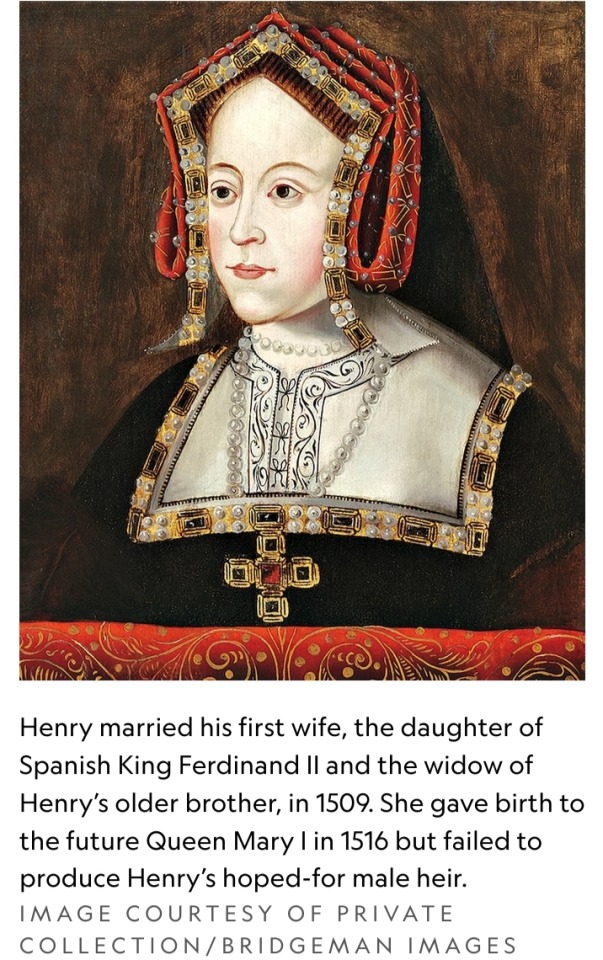
Larger-than-life Henry VIII ruled England for 36 years (1509-1547), raging war against France and Scotland, separating from the Catholic Church, and paving the way for the constitution of England, among other political achievements.
But young Prince Henry was not destined to be king. When his older brother Arthur died in 1502 at age 15, Henry became the heir to the throne.
When Arthur died, Henry didn’t just inherit the throne—he inherited his brother’s fiancée, Catherine of Aragon.
After marrying, the two became parents to a son—who tragically died two months later.
Their daughter Mary was born in 1516, but by 1526, the marriage had not produced the male heir Henry needed to secure the succession.
He began looking for a new bride, even though the Catholic Church made it impossible to divorce Catherine.
In the end, the answer was simple:
Henry believed he was a king ordained by God, so he, not the pope, had ultimate authority over his kingdom; as such, he could grant his own annulment.
This decision led to England’s break with the Catholic Church—and the creation of the Anglican Church.
After their annulment, Catherine was given the title “Dowager Duchess of Wales,” and she lived out her days at Kimbolton Castle. She died in 1536 from cancer at the age of 50.
Mary, by the way, went on to become Queen of England and Ireland from 1553 to 1558, during which time she fought to reverse the English Reformation, brought about during her father’s reign.
Beheaded: Anne Boleyn
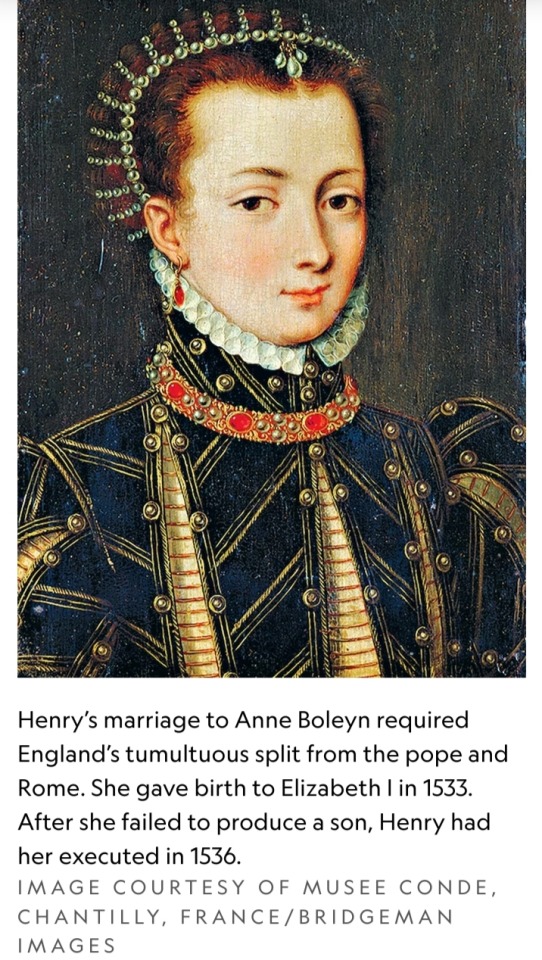
While still married to Catherine, Henry had begun wooing a court beauty, Anne Boleyn, and was determined to marry her.
A lady-in-waiting to Catherine, Anne was sophisticated, charming, and confident.
She is commonly believed to be the wife he loved the most.
As his advisers worked on “the King’s great matter” of the divorce, the couple had to wait seven years to be married—though the two flaunted their relationship in court.
He wrote her love letters, which still exist today:
“I hope soon to see you again,” he wrote, “which will be to me a greater comfort than all the precious jewels in the world.”
Anne was six months pregnant when they finally said “I do” in June 1533. Three months later, she gave birth to Elizabeth I.
She had two stillborn children and suffered a miscarriage in 1536; the fetus appeared to be male. Henry still did not have his heir.
Little by little, Henry grew tired of Anne, and his eye caught sight of a new woman: Jane Seymour.
To end the marriage, Henry needed to find a way out—and he found it through accusing Anne of high treason.
For the crimes of adultery, incest and plotting to murder the king, Anne was arrested and imprisoned in the Tower of London.
She went on trial, denied all charges, but was found guilty.
Anne was beheaded on 17 May 1536 at the Tower and buried in an unmarked grave beneath the Parish Church there.
Died: Jane Seymour

While married to Anne, Henry visited the Seymour home. It was believed that was when he first laid eyes on Jane, who served as a lady in waiting for both Catherine of Aragon and Anne Boleyn.
As in his relationship with Anne, Henry began courting Jane while still a married man.
Beautiful and reserved, she was a stark contrast to his first two wives. Before long, rumors of his attraction to her spread.
He proposed to her the day after Anne Boleyn’s execution, and they were married a month later.
She bore a son, the future Edward VI, in 1537 but died within 12 days of giving birth.
She is the only wife buried with him in the same tomb in St. George’s Chapel at Windsor Castle.
Divorced: Anne of Cleves
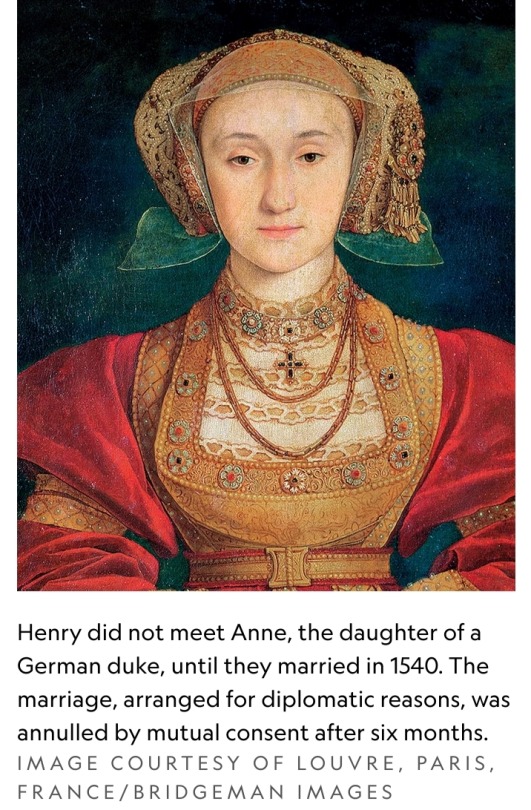
Henry’s ministers searched high and low for a new wife for the king, whose abysmal marital reputation preceded him.
Anne of Cleves, the daughter of a German duke, became a prospect for diplomatic reasons:
The marriage would ally England with a Protestant duchy, thus solidifying England’s religious reformation.
But Henry needed to know what she looked like, so, on the advice of Thomas Cromwell, he sent his favorite court painter, Hans Holbein the Younger, to the German duchy.
He approved based on the portrait.
When Anne arrived, however, he was crestfallen to see she was not as fair as reported.
(Remember, he was no great looker at that time of his life—obese, in chronic pain, with an unpredictable temper.)
Nevertheless, they were married at Greenwich Palace on 6 January 1540, but he was already looking for a way out.
The marriage was annulled six months later, on the technicality that it hadn’t been consummated.
She was given Hever Castle (Anne Boleyn’s former home) and the title “King’s Beloved Sister.”
Thomas Cromwell was not so fortunate; Henry had him executed for his miscalculation.
Beheaded: Catherine Howard

Henry was 49, and Catherine was 19 or 20, when he spotted her among the ladies in waiting to his previous wife, Anne of Cleves.
Vivacious and full of energy, the young Catherine had no choice in the matter. The pair married in 1540, three weeks after his separation with Anne.
She became his trophy wife.
No doubt turned off by her much older husband (who suffered from various ailments including ulcerous legs), she fell in love with Thomas Culpeper, one of Henry’s young advisers.
The Archbishop of Canterbury, Thomas Cranmer, found out, and he reported her indiscretions—including those that occurred before their marriage with other men—to Henry.
She was charged with “unchastity” before her marriage, concealing her indiscretions, and adultery: acts of treason.
She was executed on 13 February 1542.
Survived: Catherine Parr
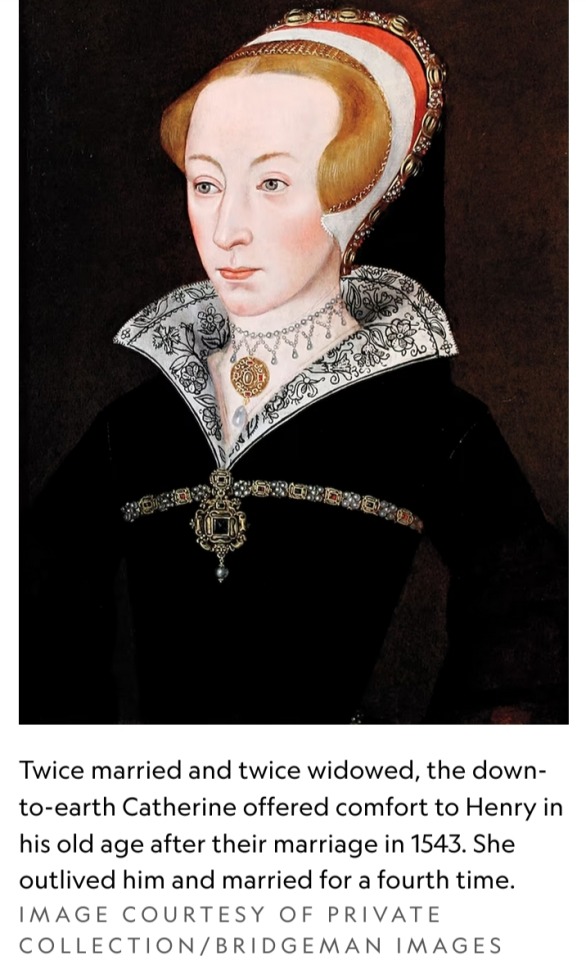
Twice married and twice widowed, the down-to-earth Catherine was reluctant at first to marry Henry. Who wouldn’t be?
She knew the fates of his previous wives, though she also knew that refusing the king could have drastic consequences.
She had caught his eye when she had been part of the household of Princess Mary, the king’s daughter.
They were married in 1543. By all reports, she was a loving, pious wife who offered comfort to Henry in his old age.
She helped Henry to reconcile with his two daughters, Mary and Elizabeth, and ensured they were educated and restored to succession.
She outlived him and married for a fourth time.
#King Henry VIII#Catherine of Aragon#Dowager Duchess of Wales#Anne Boleyn#Jane Seymour#Edward VI#Anne of Cleves#Thomas Cromwell#Hans Holbein the Younger#Thomas Cranmer#Catherine Howard#Catherine Parr#Mary Tudor#Mary I of England#Bloody Mary#Queen Elizabeth I#Queens of England#British Royal Family#King’s Beloved Sister
10 notes
·
View notes
Text
7 September 1548: THE FUNERAL of the Dowager Queen
Evesham Journal
7 September 1548: THE FUNERAL of the Dowager Queen Katherine Parr. It was the first Protestant funeral held in English. Her chief mourner was Lady Jane Grey. She was buried in St Mary’s Chapel on the grounds of Sudeley Castle, Gloucestershire, England.
‘A Breviate of the Internment of the lady Katherine Parr, Queen Dowager, late wife to King Henry VIII, and after, wife to Sir…

View On WordPress
#7 September 1548#catherine parr#dowager queen#Dowager Queen Catherine#Dowager Queen Katherine#first Protestant funeral in England#funeral of Catherine parr#funeral of Katherine Parr#henry viii#katherine parr#Lady Jane Grey#lord seymour#Queen Katherine Parr#st Mary’s chapel#sudeley castle#Thomas Seymour
1 note
·
View note
Text
the worldbuilding in Queen Charlotte is frankly insane. Would love to know how the writer’s room got to a point where they went, “you know what? It’s not only reasonable but highly likely that the dowager Queen of England can DOUBLE THE SIZE OF THE ARISTOCRACY IN SIX HOURS ON A WHIM.”
217 notes
·
View notes
Photo
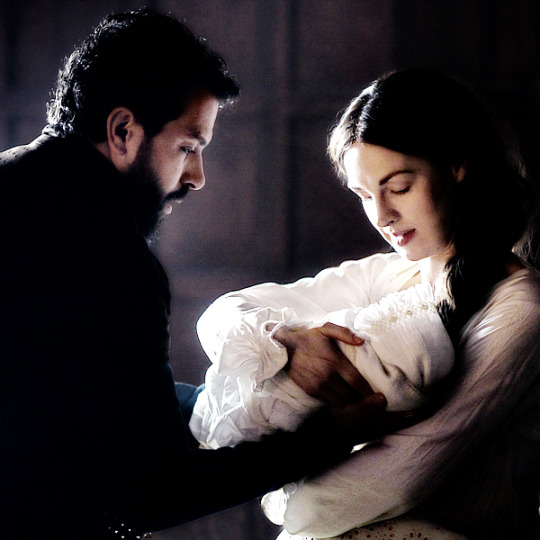
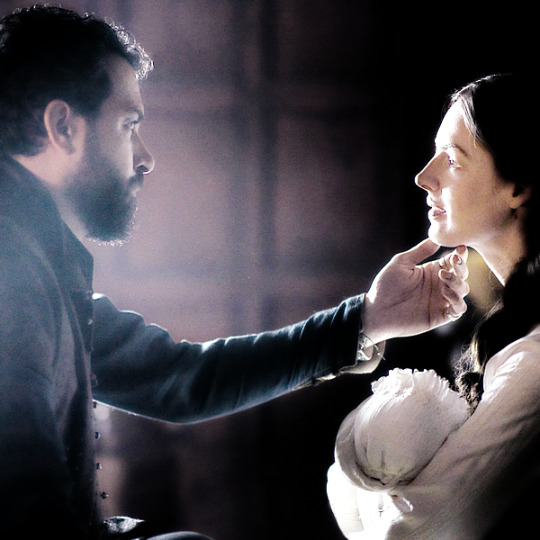
30th of August 1548 - Mary Seymour, only child of Catherine Parr, Queen Dowager of England and her husband Thomas Seymour, Baron Seymour of Sudeley is born at Sudeley Castle.
Mary was to be Catherine’s first and only child out of her four marriages. She is assumed to be named after Catherine’s royal step daughter The Lady Mary. Mary was also born the step sister of King Edward VI by her mother and the cousin of the King through her father.
#becoming elizabeth#becomingelizabethedit#perioddramaedit#jessica raine#tom cullen#Catherine Parr#katheryn parr#katherine parr#katharine parr#kathryn parr#Kateryn Parr#thomas seymour#Mary Seymour#edit#ours#ours: edit#tv: becoming elizabeth
117 notes
·
View notes
Photo

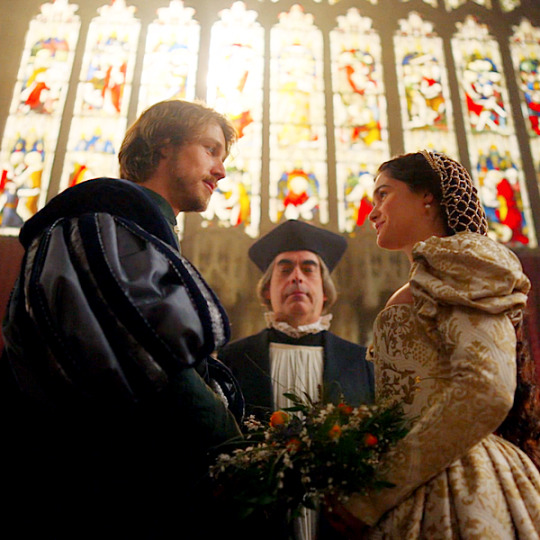
♛ Hotel de Clugny, Paris, March 3rd, 1515 ♛
Wedding day of Mary Tudor, Queen Dowager of France and Princess of England & Charles Brandon, Duke of Suffolk and Viscount Lisle.
#the spanish princess#thespanishprincessedit#perioddramaedit#sai bennett#jordan renzo#mary tudor#mary queen of france#mary rose tudor#mary; queen of france#Charles Brandon#my edits#*historicaldate#tudorerasource#dailytudors
193 notes
·
View notes
Note
William realizing he’s been half ass-ing it? Then we would be seeing more of him than ever before and that’s not happening. Look, I respect W&K for putting their family first. It’s something many previous royals haven’t done and it can be challenging to balance it. BUT let’s be honest, they do live a life of privilege and part of that life is the responsibility of duty. Most royals have been MIA for weeks now, and with Charles and Catherine out, William can/should be stepping up. It’s not like regular folks that need to work 2 jobs or long hours plus take care of their home. For a few months while the King and his wife are out, he can easily get help to take care of his family while he’s out working. I respect William and Catherine but this is the moment for him to shine.
This is really what it comes down to. Look to Denmark - King Fred & Queen Mary are off on their jollies and the dowager queen Daisy is regent a month after her abdication. Meanwhile, in England, the King has cancer and is doing his duty while William has a nice half term break with his wife and kids.
This fandom has a thing about making Camilla into a demon but guess who's out there doing all these bloody engagements. If not for her and Anne, all hell would break loose, and these same people who excuse W&C would criticise them.
It's not hard to do your fucking job.
37 notes
·
View notes
Text

I am very excited to finally be able to tell everyone that these past few months I’ve been working on a fic for the @mlbigbang 2023! Thank you to @burntwaffle12 , @sizzleissues and @karin848 for all their encouragement and support. The first post will appear January 6.
Queen Marinette: A Royal Engagement
Rating: M
Tags: Royalty AU, King!Adrien, Princess!Marinette, arranged marriage
Summary: Princess Marinette had always known she would marry for duty, but she had never even heard of King Adrien until her betrothal (she would know, because she had looked up all the crown Princes within a hundred mile radius).
Nevertheless, her parents were delighted at the offer of marriage and her uncle was given the privilege of escorting her to England for her wedding and the whole thing felt wrong.

Preview
“Who is this King of England? Why have we never heard of him before?” She demanded, her uncle surprised at her sudden interest.
“He is heir to the throne, he needs a queen, and he has chosen you.”
This she already knew, it was not a very good answer. “But why?” she pressed. “There are hundreds of nobles out there, with far grander titles and claims than our own. Why me?”
Her uncle looked surprised, he opened his mouth to speak but closed it again pensively.
The word Why was always one of the first, and favourite, questions asked by a child, and for good reason. Because Why are always the hardest questions to answer.
But why not?
Marinette was young, of child-bearing age, accomplished, and a beauty by all accounts. She had good graces and was well educated. She would make any country a worthy Queen.
Marinette was also very well aware of her precarious situation, her own mother was sent to a foreign country and married, a common enough arrangement. It was an auspicious match, a marriage between a Chinese Princess and a French nobleman in an effort to ease Sino-Franco relations.
“No, surely there must be other more diplomatic ways?” His sister and her own mother, Sabine, said when her own betrothal was announced.
Her mother protested as much as she did. All that consternation for nothing, for when the pair first set sight on each other they fell in love immediately. It has happened before, and it will all happen again.
Her mother of all people would know.
As Marinette’s ambassador, he was honoured to go with her to secure a friendship with the British, offering stability and prosperity. There was silk and tea to be traded, as well as porcelain. In return, they would resolve animosity held over past incidents. The East India Trading Company had a vested interest in the marriage and there was still disgruntled talk over the Flint Affair, such that war was imminent between the Chinese and British Empires.
Wang Cheng looked at Marinette with sympathy. He was very fond of his niece, and in his opinion she deserved the world. On paper everything looked like a suitable match, she was 18 and he was only 21. He spoke Mandarin, French and Latin, in addition to his mother tongue; and she knew a passable amount of English and Mandarin; as well as French, her native tongue.
She would like him. He was convinced.
However, the older gentleman himself did not know the King either. By all accounts he thought that the late King and Queen Dowager of England were barren, but then again he never paid attention to bedroom gossip.
“Why have I never heard of this king before?” The young woman insisted, her blue eyes flashing. She had the same kind of fire in her as his sister, masked by a gentle nature that lashed out when provoked like a tiger.

If you know anything about me, then you know I have written another Bridgerton AU 🫠! Queen Marinette - A Royal Engagement. Posting begins 6 January
42 notes
·
View notes
Text






𝑰𝒏𝒕𝒆𝒓𝒏𝒂𝒕𝒊𝒐𝒏𝒂𝒍 𝑹𝒐𝒚𝒂𝒍/𝑰𝒎𝒑𝒆𝒓𝒊𝒂𝒍 𝑨𝒑𝒑𝒓𝒆𝒄𝒊𝒂𝒕𝒊𝒐𝒏 𝑴𝒐𝒏𝒕𝒉:
𝑾𝒆𝒆𝒌 1: 𝑸𝒖𝒆𝒆𝒏/𝑬𝒎𝒑𝒓𝒆𝒔𝒔 𝑫𝒐𝒘𝒂𝒈𝒆𝒓𝒔
𝑫𝒂𝒚 5: 𝑪𝒂𝒕𝒉𝒆𝒓𝒊𝒏𝒆 𝑷𝒂𝒓𝒓, 𝑫𝒐𝒘𝒂𝒈𝒆𝒓 𝑸𝒖𝒆𝒆𝒏 𝒐𝒇 𝑬𝒏𝒈𝒍𝒂𝒏𝒅
#catherine parr#dowager queen of england#the tudors#international royal/imperial history appreciation month:week 1
6 notes
·
View notes
Text
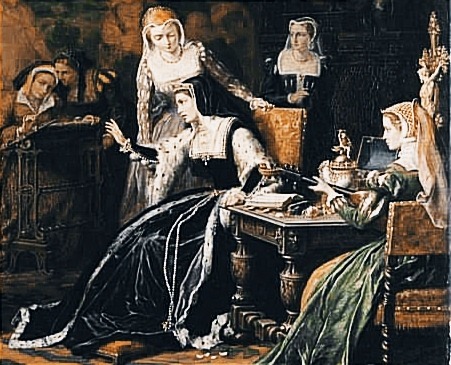
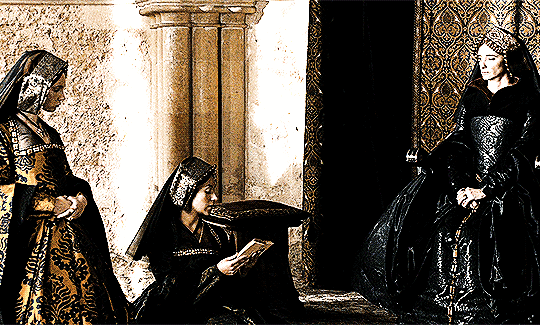
Katharine considered herself the King’s wife until the end. The law in England forbade married women to write their last wills, but Katharine dictated a document similar to a testament in which she made several bequests and settled her debts. It is clear that Katharine still owned valuable possessions such as gold and silver jewellery and luxurious gowns she wanted to be made into vestments for a convent of Observant Friars, where she desired to be buried. The bequests in Katharine’s last will reveal an intricate network of women who remained loyal to the former Queen, although it is clear that not all of these ladies served Katharine until her death. Katharine’s first bequest was to her favourite maid of honour, Elizabeth Darrell, who received £20 “for her marriage”. Elizabeth was a daughter of Sir Edward Darrell of Littlecote who served as Katharine of Aragon’s vice-chamberlain between 1517 and 1530. He died in March 1530, leaving his daughter under Katharine of Aragon’s protection. Elizabeth was one of the eight ladies in Katharine’s household who refused to swear an oath to Katharine as Princess Dowager of Wales, arguing that she swore an oath to Katharine as Queen and swearing other oaths would be equal to perjury. After Katharine’s death, Elizabeth became the mistress of Sir Thomas Wyatt, the famous Tudor poet, and found a new employer in the person of Gertrude Courtenay, Marchioness of Exeter. Other women mentioned in Katharine of Aragon’s testament were Blanche Twyford, who received £10, Margery Otwell and Dorothy Whiller, who received £10 each, Mary de la Sa, wife of Katharine’s Spanish physician, who received £40, and Isabel Vergas, Katharine’s Spanish lady-in-waiting, who received £20. There were also “little maidens”, “Mistress Isabel, daughter of Mistress Margery” and a laundress. Little is known about these women except for their names. Some, like Isabel Vergas, who was recorded in the royal household as Katharine’s chamberer in 1511, must have been long-term servants, and trusted ones at that. Elizabeth Darrell, Margery Otwell, Blanche Twyford and Dorothy Whiller were among the eight ladies who refused to swear the new oath in 1533; they clearly remained staunchly supportive of Katharine, and it is highly likely that they served her in 1536. Katharine begged the King to safeguard the marriage portions for her unmarried maids, “they being but three”, and Henry clearly felt responsible for these women. In November 1539, Blanche Twyford was rewarded with £66 “for her long and painful service done unto the Princess Dowager”; whether other ladies were rewarded in the same manner remains unclear.
Sylvia Barbara Soberton, Great Ladies: The Forgotten Witnesses to the Lives of Tudor Queens
16 notes
·
View notes
Photo
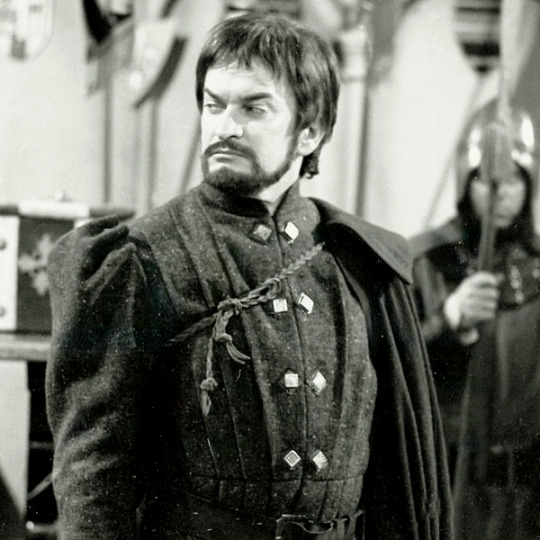

Derek Godfrey as Owen Tudor with Dorothy Tutin as Catherine of Valois, Dowager Queen of England
BBC’s The Queen and The Welshman (1966)
#the queen and the welshman#perioddramaedit#derek godfrey#dorothy tutin#Owen Tudor#Catherine of Valois#Catherine de Valois#catherine de'valois#edit#play: the queen and the welshman#movie: the queen and the welshman#original edit
98 notes
·
View notes
Note
How is the relationship between Margaret of Anjou and Jacqueta of Luxembourg? (Jacquetta was one of the three people who convinced her not to enter London, which made me fantasize about their relationship.)
We simply don't know a lot about their relationship. Jacquetta does seem to be prominent at court during Margaret's time as queen consort but we don't know if this indicates - or led to - any personal closeness between the women. We know the Woodvilles had a close affiliation with the House of Lancaster and Jacquetta was the widow of Henry VI's uncle, John, Duke of Bedford and the dowager Duchess of Bedford so that may well have been the reason for her prominence. Jacquetta could also claim a familial connection with Margaret herself: her sister, Isabel, had married Margaret's uncle, Charles of Anjou, Count of Maine. The idea that Jacquetta and Margaret were especially close seems to have been popularised by Philippa Gregory in her novel, The Lady of the Rivers, and her biography of Jacquetta in The Women of the Cousins' War but historians are more cautious.
Jacquetta and her husband were part of Margaret's escort to England in 1445. According to B. M. Cron, Jacquetta attended Margaret's coronation banquet and was seated on Margaret's right - this is far more likely to be due to her being the first lady in the land after Margaret than an indication of their closeness; Humphrey, Duke of Gloucester was seated on Margaret's left and the idea of Gloucester being a close friend of Margaret is not credible. Cron also claims that Richard Woodville was Margaret's champion in the jousting festivities that followed. Lynda J. Pidgeon claims it is "significant" that Richard Woodville was not created a baron until after Henry VI's marriage to Margaret, but credits it more to Henry's desire to "create a royal family around him" than to any relationship between Margaret and her escort.
Jacquetta's servants were regularly given gifts by Margaret in the New Years celebrations. In 1446, her servants received 53s. 4d. and in 1447, 1449 and 1452, Jacquetta's servants received 66s. 8d. This is on a par with other gifts to ducal servants - in 1446, this was the same amount given to the servants of the Duke of York and Duchesses of Buckingham and Exeter, while in 1447, the same amount was given to the servants of the Duke of Gloucester, the Archbishop of Canterbury and the Duchess of Buckingham. Jacquetta herself was only given gifts by Margaret in 1447 and 1452 according to Pidgeon but I'm not sure what the source is for that and neither Helen Maurer nor A. R. Myers mention it when discussing Margaret's accounts. Not all of Margaret's accounts survive so we don't have the full picture.
Jacquetta attended Margaret's churching after the birth of Edward of Lancaster in 1453. Jacquetta and her husband were part of Margaret's court during her extended stay in the midlands beginning in 1456, though, according to Pidgeon, they are only rarely mentioned as being present. This is may have been due to the frequency of Jacquetta's pregnancies keeping her away from court.
And yes, Jacquetta was one of three women (the others being Lady Scales and Anne, the dowager Duchess of Buckingham) who accompanied a delegation of London aldermen who convinced Margaret to send her army away. As Helen Maurer says:
Both Jacquetta, the dowager duchess of Bedford, and Ismania, Lady Scales, had been among the women who had escorted Margaret from France, and Lady Scales had remained in her household as a personal attendant. All three ladies had been recipients of New Year's gifts at various times, and Anne, duchess of Buckingham had stood godmother to Prince Edward. Though the personal relationships that existed between Margaret and these women are difficult to assess, it is apparent that the mayor and aldermen believed that they would be received with trust and favor.
Jacquetta's prominence at the Lancastrian court may explain the tradition that her daughter, Elizabeth Woodville, was a lady-in-waiting to Margaret. There is, however, no evidence of that Elizabeth served Margaret and historians have generally poured doubt on the idea. One exception is Susan Higginbotham who suggested that it is still possible that Elizabeth was one of Margaret's damsels, saying if that Elizabeth did serve Margaret , it's "more likely that she did so in the late 1450s, a period for which Margaret's household records do not survive".
There is no evidence to tell us what Margaret thought of the marriage of Elizabeth Woodville and Edward IV or the Woodvilles' defection to the House of York. There is no evidence Jacquetta and Elizabeth feared Margaret especially during the Readeption - it would be very, very surprising if they feared her more than Richard Neville, Earl of Warwick (after all, it was in Warwick's attempt to depose Edward IV in favour of George, Duke of Clarence that had seen Jacquetta's husband and son executed, presumably without trial).
Nor do we know if, in the aftermath of the Lancastrian defeat at the Battle of Tewkesbury and Margaret's capture by Yorkist forces, whether Jacquetta met with or attempted to advocate for Margaret before her own death in 1472. We do not know if anyone advocated for Margaret's imprisonment to made more bearable, who decided her jailer would be Alice Chaucer, dowager Duchess of Suffolk and an old friend. If anyone did, I suspect it would be Jacquetta or Elizabeth Woodville (possibly in memory of her mother's friendship). It is tempting to speculate that Margaret's entry into the London Skinners’ Fraternity of the Assumption of the Virgin Mary in c. 1475 came about due to Elizabeth's influence (Elizabeth had entered the fraternity in c. 1472) but there's simply no evidence of it. It makes for a nice story, though.
In contrast to Maurer, Pidgeon is fairly doubtful of the idea that Jacquetta and Margaret were friendly, citing first the lack of mention of their attendance on Margaret and the lack of New Year's years gifts given to Jacquetta, saying:
Margaret’s apparent lack of friendship for Jacquetta might also be explained by Jacquetta’s Burgundian connections. Jacquetta’s father had been responsible for the capture of Margaret’s father at the Battle of Bulgnéville in 1431, following which René had been held prisoner by the Duke of Burgundy for some years until his ransom was paid. Margaret was also concerned to promote French interests to Henry and any reminder of a previous Burgundian policy might have been frowned upon. It was widely believed that it was through Margaret’s prompting that Henry had agreed to surrender Maine to René of Anjou in 1445.
However, Pidgeon bases some of this on the claim that Margaret "probably detested" the English, which we don't know and seems to be drawn from Yorkist and Tudor stereotypes of Margaret. As for the claim that Margaret pushed for Henry VI to surrender Maine to her father, it is true that she was blamed for it but what role, if any, she actually played is unknown. It is more likely that the surrender of both Maine and Anjou was an unofficial promise made by the English delegation in the negotiations that resulted in the Treaty of Tours (1444). Given Margaret was a 14-year-old girl at the time, it is incredibly unlikely she was responsible for that promise. She was urged to intercede with Henry to ensure the fulfilment of that promise but we simply don't know if she did or even what she thought about it. As I say here, she was still in her teens when the handover occurred and we must be wary of the misogyny embedded in the narrative that a teenage girl was responsible for the actions of an adult man - who, after all, was surrounded by experienced and mature advisors.
In short, the answer is that we don't know what the relationship between Margaret and Jacquetta was like. We see Jacquetta given favour in keeping with her status as a duchess and in keeping with her family connections to both Margaret and Henry. If any special relationship grew up between Jacquetta and Margaret, if they became close friends, there is little evidence to show it.
The Woodvilles were loyal to the Lancastrians throughout the resumption of the Hundred Years War until the Lancastrian defeat at the Battle of Towton. How much of that can be credited to the Woodvilles' traditional loyalties or Jacquetta's personal ties to Henry VI (who, after all, was her nephew by marriage) versus a (hypothetical) close relationship between Margaret and Jacquetta is unknown.
Philippa Gregory made much of this limited evidence, while Maurer more cautiously suggests that Margaret looked on Jacquetta as someone she could trust. Pidgeon, on the other hand, argues that there was no friendship between the women. I have my suspicions about why Pidgeon argues that (I haven't read her whole book so I can't say for sure).
Personally, I've tended to imagine a connection that dimmed over time due to diverging lives - Jacquetta's frequent pregnancies kept her away from court, Margaret's life became absorbed by the political struggles of the Lancastrian court. The simple fact is that we don't know - there isn't anywhere enough evidence to judge - and you're free to imagine what you like.
Sources
B. M. Cron, Margaret of Anjou and the Men Around Her (History and Heritage Publishing 2021)
Philippa Gregory, David Baldwin and Michael Jones, The Women of the Cousins' War: The Duchess, the Queen, and the King's Mother (Atria Books 2011)
Susan Higginbotham, The Woodvilles (The History Press 2013)
Helen Maurer, Margaret of Anjou: Queenship and Power in Late Medieval England (Boydell Press 2003)
A. R. Myers, "The Jewels of Queen Margaret of Anjou", Bulletin of the John Rylands Library, vol. 42, no. 1 (1959)
Lynda J. Pigdeon, Brought Up Of Nought: A History of the Woodville Family (Fonthill 2019)
9 notes
·
View notes